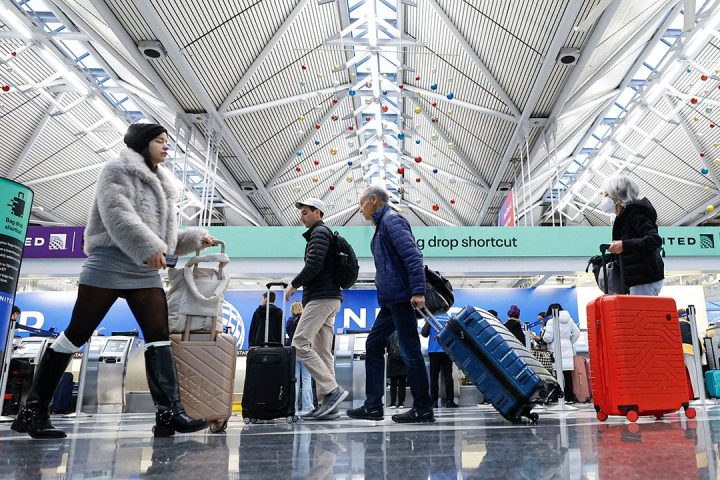More workers are holding onto their jobs, even if they don’t necessarily feel optimistic about their employers’ future.
The U.S. is expected to add 170,000 jobs in September, keeping the increase below 200,000 for the fourth month in a row, according to Labor Department data released Friday. The last time that happened was in 2018. The percentage of jobless Americans seeking work fell slightly to 3.7% from 3.8%.
While the number of quits — workers who voluntarily left their jobs — remained relatively flat at 3.6 million or 2.6% of employed people in August, 30,000 fewer employees in the tech-heavy information sector quit their jobs in August compared to the previous month.
That’s according to seperate data released this week by the Labor Department’s Job Openings and Labor Turnover Survey, or JOLTS, report. The latest figures mark the biggest decrease in job quitters in August among all industries.
Workers tend to stay at their jobs when new jobs are harder to find and when the economy is weakening. Since the start of the pandemic, labor shortages pushed up wages and employers have been on a hiring spree, which resulted in many workers, regardless of sector, job hopping in search of opportunities with better pay.
“‘When employers are nervous, they slow their hiring. Likewise, when jobseekers are nervous, they’re not as ready to switch jobs.’”
“This is market nervousness,” Andrew Crapuchettes, CEO of careers website RedBalloon, told MarketWatch. “When employers are nervous, they slow their hiring. Likewise, when job seekers are nervous, they’re not as ready to switch jobs.”
Over a year ago, quits rate surged to 3.3% — about 4.5 million job departures — coining the term the Great Resignation. The trend seemed to have died down by July when the quit rate returned to its pre-pandemic level of 2.6%.
“During the COVID-19 pandemic, there was a drop in the quits rate since workers put a higher value on job security,” Crapuchettes added. “Post-pandemic, job seekers were in the driver seat with record high job openings across the country, so there was an acceleration in job switching. Now, some of the jobseeker nervousness has returned with the choppy economic conditions, so they are settling into their current roles for the time being.”
There was, however, other encouraging news: layoffs in the tech sector have slowed. The industry announced that it would lay off 3,198 positions in August, the lowest monthly total for the sector since June 2020, according to outplacement firm Challenger, Gray & Christmas.
“‘The tech sector has seen a 180-degree turn in labor demand from two years ago, with bidding wars and The Great Resignation giving way to layoffs and hiring freezes.’”
“The tech sector has seen a 180-degree turn in labor demand from two years ago, with bidding wars and the Great Resignation giving way to layoffs and hiring freezes,” Greg McBride, chief financial analyst at Bankrate.com, told MarketWatch. “If the economy averts a recession, continued economic growth will spur a recovery in tech hiring.”
The big picture: workers — both inside and outside of the tech sector — want jobs, and they especially want more hours to boost their income, with high inflation and rising interest rates making everything from credit cards to mortgages more expensive. Inflation was 3.7% in August and, after several rounds of the Federal Reserve hiking interest rates, the Fed’s benchmark interest rate now ranges from 5.25% to 5.50%.
Workers are not feeling particularly confident about their job security, according to a recent survey by the online job searching platform Glassdoor. The share of employees who say they feel confident about their employer’s business outlook over the next six months fell to a low of 45.8% in September, the lowest level since Glassdoor began surveying workers in January 2016. A year ago, it was at 54%.
Employees in the information sector saw the biggest decline in confidence compared to a year ago. Between September 2022 and September 2023, there was a 13.2-percentage-point drop in the share of information-industry workers who felt confident about their company’s next six months.
This was likely a reflection of anxiety over the layoffs that have hit Big Tech companies over the past year, Glassdoor noted. More than 238,000 tech employees globally had been laid off as of September.
“‘The drop [in quits] between July and August may suggest that workers are wary of a weaker economy and staying put in current jobs, or, it could mean that workers are experiencing less burnout.’”
The economy also added 9.6 million job openings in August, up from 8.9 million in July, the JOLTS report also said Tuesday. The increase was led by an increase in jobs in professional and business services, which saw a 35% jump in openings compared to the previous month and contributed more than 500,000 jobs out of a net increase of more than 700,000 jobs.
Most of the openings were concentrated in certain parts of the labor market — in the professional and business-services sectors and, to a large extent, in small businesses rather than larger corporations.
This is likely a sign that the increase in openings is “the result of statistical noise,” rather than “a meaningful improvement in labor market conditions,” said Julia Pollak, chief economist at online job searching platform ZipRecruiter.
Although the most recent jump in job openings surpassed economists’ predictions, hiring has slowed significantly from a year ago.
Others say quit rates, as laid out in the JOLTS data, are part of a long-term trend. “The decrease in quits amongst tech workers, while large in comparison to other changes in the month of August, is well in line with levels of quits seen in the industry pre-pandemic, as well as levels and rates seen earlier this year,” Rachel Sederberg, senior economist at Lightcast, a labor-market analytics firm, told MarketWatch.
“The drop between July and August may suggest that workers are wary of a weaker economy and staying put in current jobs, or, it could mean that workers are experiencing less burnout and seeing a reduced desire to switch jobs,” she said.
Quentin Fottrell contributed.
Read the full article here







